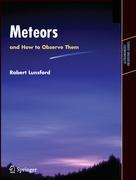Meteors and How to Observe Them
BücherAngebote / Angebote:
ASTRONOMERS’ OBSERVING GUIDES provide up-to-date information for amateur astronomers who want to know all about what it is they are observing. This is the basis of the first part of the book. The second part details observing techniques for practical astronomers, working with a range of different instruments.
Have you ever been on the beach at night, watching the sky overhead, and seen streaks of light against the background of stars? Though many people still refer to these as shooting stars, they are, of course, not stars. They are meteors—small chunks of rock and ice debris from disintegrating comets that are careening through our Solar System and sometimes enter Earth’s atmosphere. Most are so small that they burn up as they enter the atmosphere. These are called meteors. In a meteor shower, many meteors can be seen streaking across the sky in a short time. A few meteors make it through intact and descend to Earth as meteorites. Watching these beautiful streaks of light in the sky can be an exciting pastime, and it can result in some important science.
Robert Lunsford explains what meteors are, where they come from, and what happens to them as they whiz through space and enter our atmosphere. He tells how to observe meteors and meteor showers, what equipment to use, what you should look for, where you should look, and much more. Armed with the information in this book and with very little effort and equipment, you can begin your regular search of the heavens right now and join the ranks of those who have made this rewarding pastime a lifetime hobby.
Practical Astronomy
ISBN 978-0-387-09460-1
springer.com
Folgt in ca. 10 Arbeitstagen
